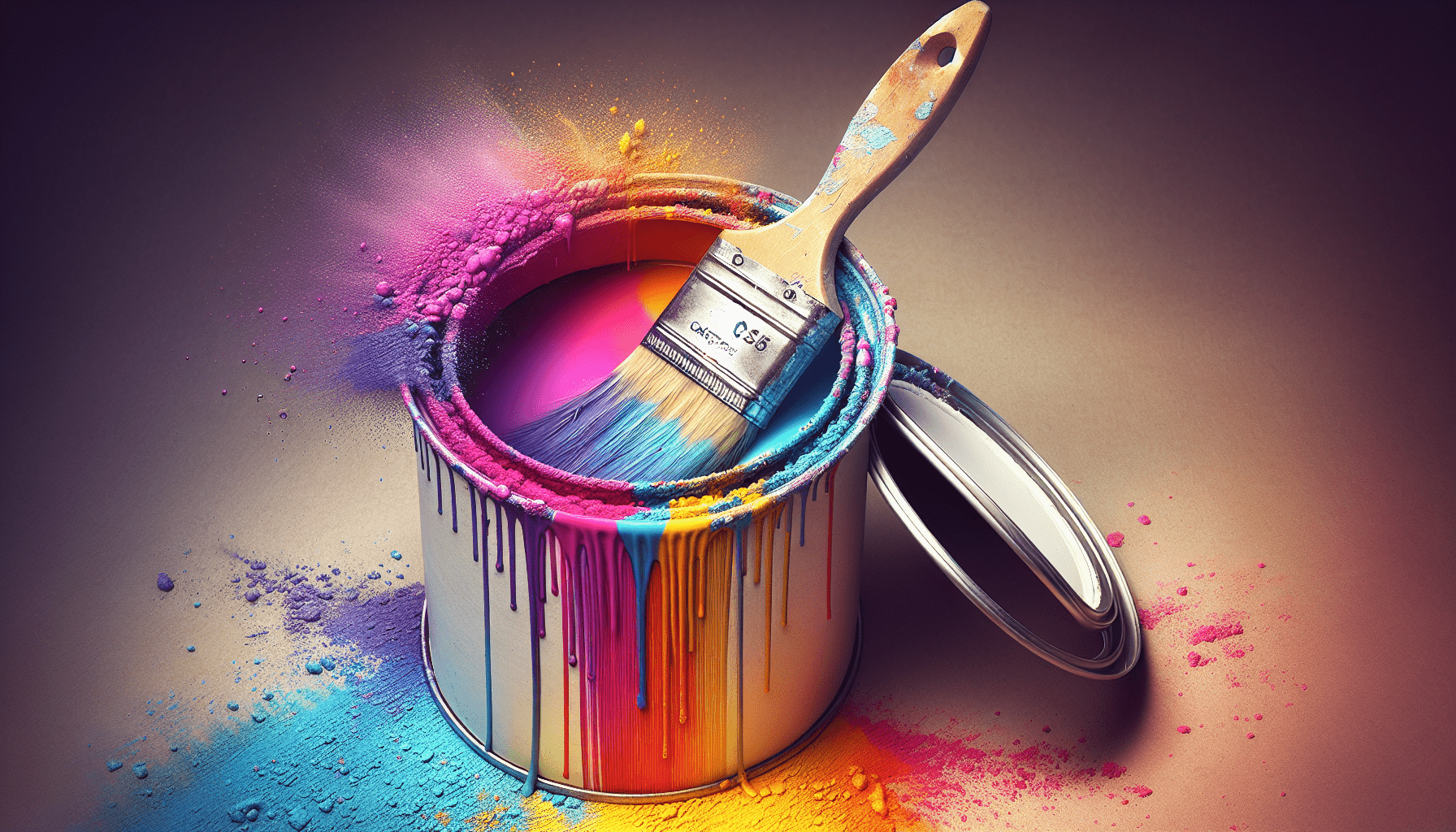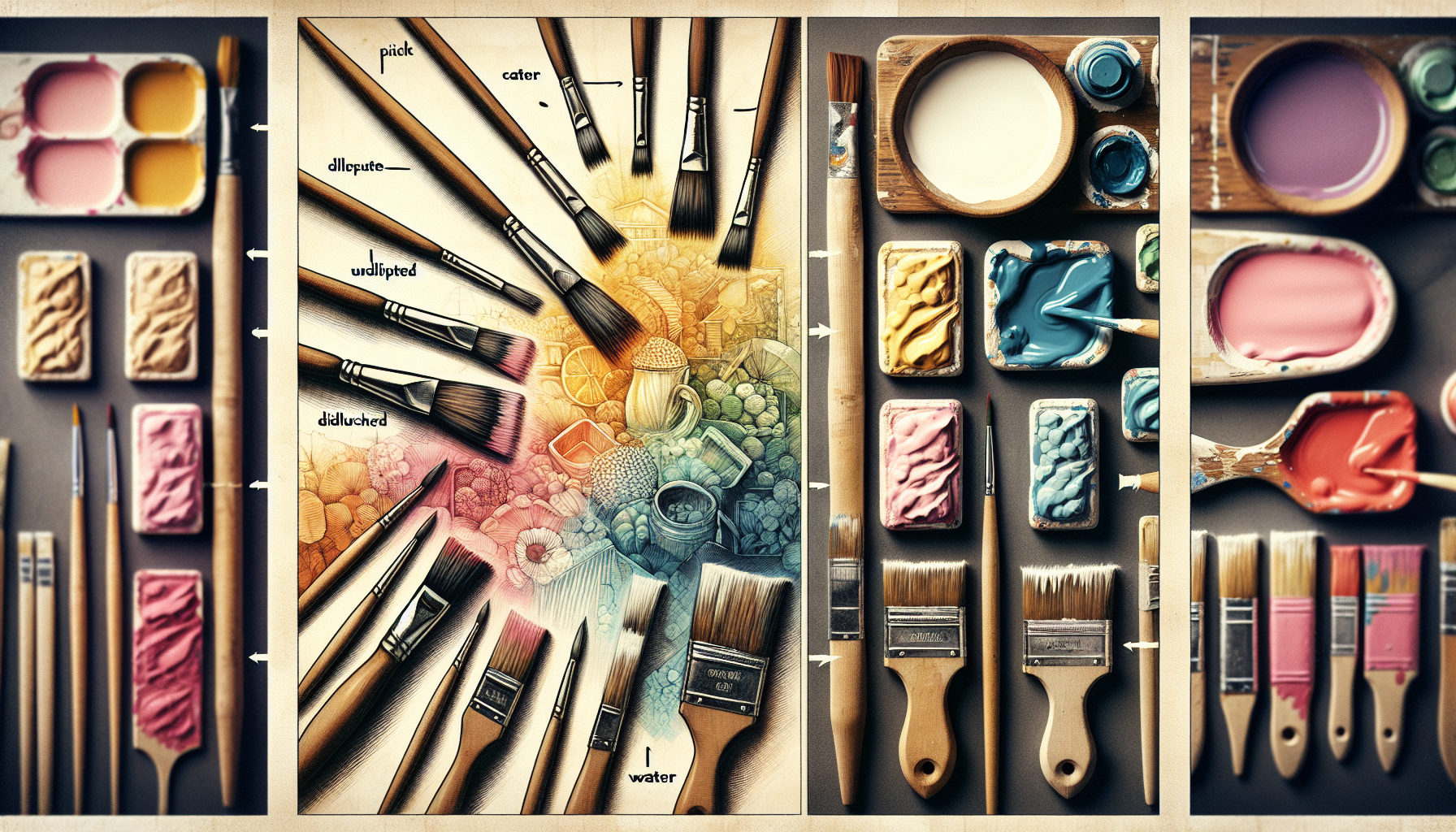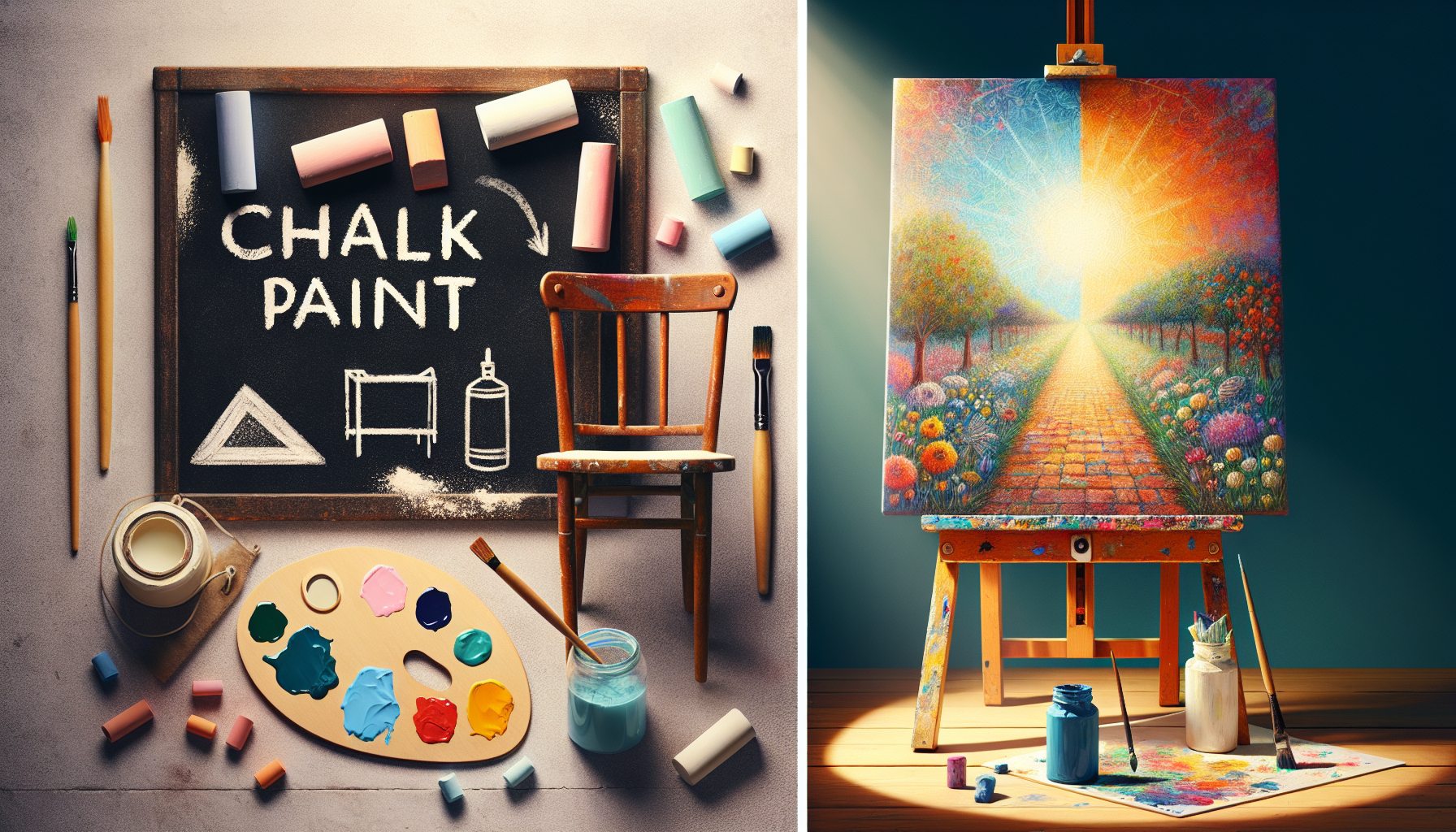When it comes to refreshing your home’s decor, the question of whether you can paint over chalk paint with regular paint arises. You may find yourself looking to change the color scheme or simply update the finish. This article explores the feasibility of painting over chalk paint with regular paint, providing valuable insights and considerations for a successful transformation.
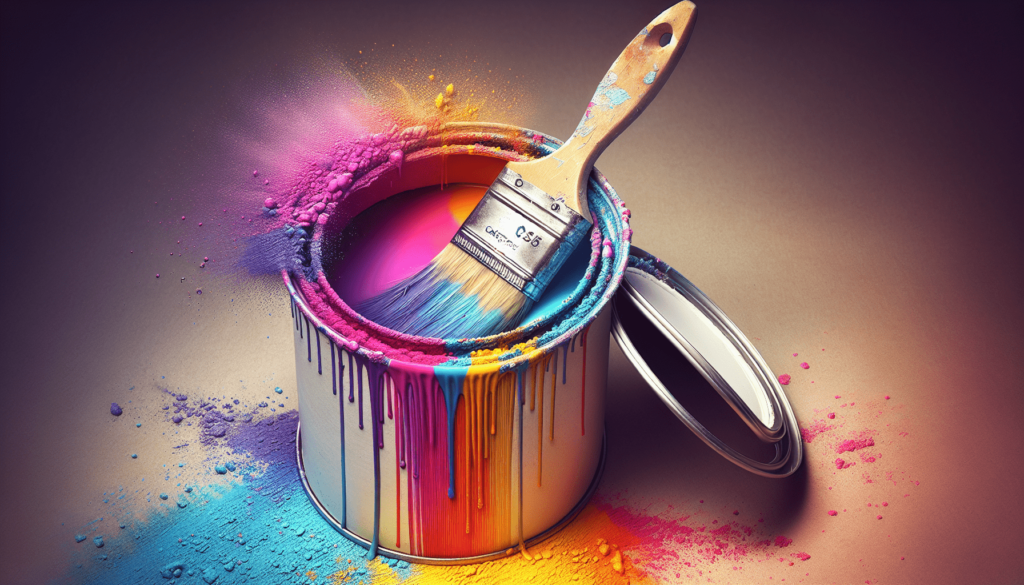
Understanding Chalk Paint
What is chalk paint?
Chalk paint is a unique type of paint that has gained popularity in recent years. Unlike traditional paint, it has a matte, velvety finish and does not require extensive surface preparation. Chalk paint gets its name from its chalk-like appearance and texture.
Chalk paint is known for its versatility and ease of use. It can be applied to a variety of surfaces, including wood, metal, and even fabric. Additionally, it has a quick drying time, allowing for efficient application and the ability to complete projects in a shorter period.
Why is chalk paint popular?
There are several reasons why chalk paint has become a preferred choice for many DIY enthusiasts and professional painters alike. Firstly, chalk paint offers excellent coverage, often requiring only one or two coats for satisfactory results. This can save both time and money compared to traditional paint that may need multiple coats for full coverage.
Another reason for its popularity is the forgiving nature of chalk paint. It can be easily distressed or aged for a vintage or shabby-chic look by lightly sanding or using a wax or sanding block. This feature provides a unique opportunity for creativity and customization.
Additionally, chalk paint is known for its low VOC (volatile organic compound) content. VOCs are chemicals that are released into the air during the drying and curing process of conventional paints, and they can have adverse health effects. Chalk paint typically contains minimal VOCs, making it a more environmentally-friendly and health-conscious choice.
Painting Over Chalk Paint
Considerations before repainting with regular paint
Before repainting over chalk paint with regular paint, there are several considerations to keep in mind. Firstly, you need to assess the condition of the existing chalk paint. If it is in good condition with no signs of chipping or peeling, you may be able to proceed with repainting. However, if the chalk paint is damaged or not adhering well to the surface, it is best to strip or sand it off completely before applying regular paint.
Another consideration is the compatibility of the regular paint with the chalk paint. Regular paint may not adhere well to the slick surface of chalk paint, especially if the chalk paint has been sealed. It is essential to conduct a patch test to ensure proper adhesion and compatibility before proceeding with repainting the entire surface.
Preparing the surface for repainting
Properly preparing the surface is crucial for achieving a smooth and long-lasting finish when repainting over chalk paint. Start by cleaning the surface thoroughly to remove dust, dirt, and any wax or sealant residue. This can be done using a mild detergent and water solution or a suitable surface cleaner.
Once the surface is clean, you may need to consider whether sanding or priming is necessary. Sanding can help create a rougher texture for better paint adhesion, especially if the surface is already smooth or has been sealed with wax. Priming can also improve adhesion, particularly when repainting over a high-gloss or heavily sealed chalk paint surface.
If there are any imperfections on the surface, such as dents, scratches, or holes, it is essential to fill them in before repainting. Use a suitable wood filler, spackling compound, or caulk to fill in any gaps or cracks. Allow the filler to dry completely, and then sand it smooth.
Choosing the right type of regular paint
When repainting over chalk paint, it is important to choose the right type of regular paint for optimal results. The two main options are latex or oil-based paint. Latex paint is more commonly used due to its versatility, ease of use, and quick drying time. Oil-based paint, on the other hand, provides a smoother finish and is more durable, but it requires longer drying and curing times.
Additionally, consider the desired finish of the repainted surface. If you want a similar matte finish to the chalk paint, opt for a flat or matte sheen in the regular paint. If you prefer a more glossy or satin finish, choose a paint with a higher sheen such as semi-gloss or high-gloss.
Take into account the intended use of the painted surface when selecting the paint type. If it will be exposed to high traffic or moisture, consider using a more durable and washable paint for increased longevity.
Lastly, consider the color coverage of the regular paint. Some lighter colors may require multiple coats to cover darker or highly pigmented chalk paint. Take this into consideration when choosing the color and quantity of regular paint needed for the project.
Testing the compatibility of regular paint over chalk paint
Before repainting the entire surface, it is essential to perform a patch test to assess the compatibility of the regular paint over the chalk paint. Choose a small, inconspicuous area and apply the regular paint according to the manufacturer’s instructions. Allow the paint to dry fully and assess the adhesion and finish.
Pay close attention to any signs of flaking, peeling, or poor adhesion. If the regular paint does not adhere well or shows any adverse reactions, adjustments may need to be made before proceeding with repainting the entire surface. It is recommended to repeat the patch test with any necessary adjustments until satisfactory results are achieved.
Considerations before Repainting with Regular Paint
Adhesion and durability
One of the primary considerations before repainting over chalk paint with regular paint is the adhesion and durability of the new paint. In some cases, regular paint may not adhere well to the slick surface of chalk paint, especially if it has been sealed with wax or a protective finish.
To improve adhesion, consider using a bonding agent or primer specifically designed for use with chalk paint. These products can enhance the bond between the chalk paint and regular paint, providing a stronger and longer-lasting finish.
Additionally, consider the durability requirements of the painted surface. If the repainted surface will be exposed to heavy use, such as furniture or high-traffic areas, it is crucial to choose a durable paint that can withstand wear and tear.
Desired finish
The desired finish of the repainted surface is another important consideration. Chalk paint is known for its matte, velvety appearance, while regular paint offers a broader range of sheens, from matte to high-gloss.
Think about the overall aesthetic you wish to achieve and choose the corresponding sheen in the regular paint. A matte finish will provide a similar look to the chalk paint, while a higher sheen will offer a more reflective and polished appearance.
Consider the lighting conditions of the room or area where the repainted surface will be located. Higher sheens may highlight imperfections or texture variations more than matte finishes. Take this into account when selecting the appropriate paint sheen.
Intended use of the painted surface
The intended use of the repainted surface is also an important factor to consider. Different surfaces may have specific requirements for durability, washability, or resistance to moisture or chemicals.
For example, if you are repainting kitchen cabinets or bathroom furniture, it is essential to choose a paint that can withstand constant exposure to moisture, heat, and cleaning products. On the other hand, if you are repainting a decorative piece or artwork, the focus may be more on achieving the desired aesthetic rather than durability.
Consider the specific needs of the painted surface and choose a paint that is suitable for its intended use.
Color coverage
Color coverage is another consideration when repainting over chalk paint with regular paint. Chalk paint is known for its excellent coverage and often requires fewer coats compared to traditional paint.
When selecting the color of the regular paint, keep in mind that lighter colors may require multiple coats to cover darker or highly pigmented chalk paint completely. Take this into account when estimating the quantity of paint needed for the project and allow for additional coats if necessary.
Additionally, consider the opacity of the regular paint. Some paints have more transparent pigments, which can allow the original chalk paint color to show through, particularly if a lighter color is being applied over a darker chalk paint.
To achieve the desired color, it may be necessary to apply a coat of primer specifically formulated to block and neutralize the underlying chalk paint color.
Preparing the Surface for Repainting
Cleaning the surface
Before repainting over chalk paint, it is crucial to clean the surface thoroughly. Use a mild detergent or surface cleaner mixed with water to remove any dirt, dust, grease, or wax residue. A clean surface ensures proper adhesion and a smooth finish for the new coat of paint.
Consider using a non-abrasive sponge or cloth to avoid scratching or damaging the chalk paint. Rinse the surface thoroughly with clean water and allow it to dry completely before proceeding with any further preparation steps.
Sanding or priming
Once the surface is clean and dry, you may need to determine whether sanding or priming is necessary. Sanding can help create a rougher texture on the slick surface of chalk paint, promoting better adhesion for the new coat of regular paint.
If the chalk paint has been sealed with wax or a protective finish, sanding becomes even more important to remove the wax and create a suitable surface for the new paint.
Start by using fine-grit sandpaper to gently sand the surface in a circular motion. Be careful not to sand too aggressively, as this can damage the underlying surface. Wipe away the dust with a clean cloth or tack cloth after sanding.
If sanding is not needed, you may proceed directly to priming. Priming can provide an additional layer of adhesion and improve the overall durability of the painted surface. Choose a primer specifically designed for use with the type of regular paint you have selected.
Apply the primer according to the manufacturer’s instructions, ensuring even coverage. Allow the primer to dry fully before proceeding to the next steps.
Filling in any imperfections
If there are any imperfections on the surface, such as dents, scratches, or holes, it is important to fill them in before repainting. Use a suitable wood filler, spackling compound, or caulk, depending on the nature of the imperfection.
Follow the instructions on the filler product for the best results. Apply the filler to the imperfection, ensuring it is level with the surrounding surface. Allow the filler to dry completely, and then sand it smooth using fine-grit sandpaper.
Removing wax or sealant
If the chalk paint has been sealed with wax or a protective finish, it is important to remove it before repainting. Wax and sealants can create a barrier that prevents proper adhesion of the new paint.
To remove wax or sealant, use a furniture wax remover or a suitable solvent that is compatible with the type of finish used. Apply the wax remover with a clean cloth or sponge, following the instructions provided.
Work in small sections and gently rub the surface to remove the wax or sealant. Wipe away the residue with a clean, damp cloth. Repeat the process as necessary until all the wax or sealant is removed.
Allow the surface to dry completely before proceeding with the next steps of repainting.
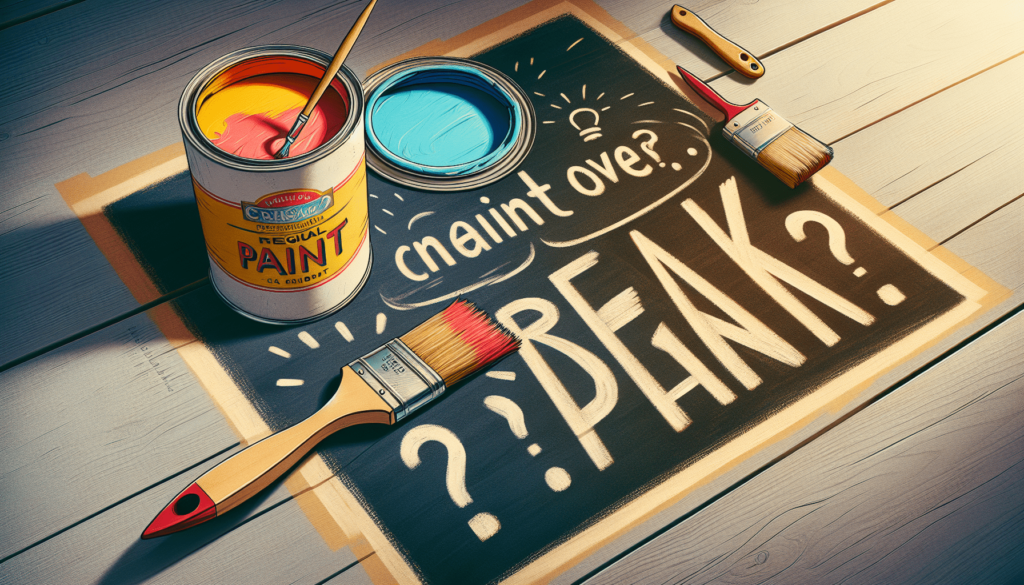
Choosing the Right Type of Regular Paint
Latex or oil-based paint
The choice between latex or oil-based paint depends on several factors, including personal preference, the desired finish, and the specific requirements of the painted surface.
Latex paint, also known as water-based paint, is a popular choice for repainting over chalk paint. It is easy to work with, dries quickly, and emits fewer fumes compared to oil-based paint. Latex paint is also more durable when it comes to resistance to cracking, fading, and yellowing over time.
Oil-based paint, on the other hand, provides a smoother and more durable finish. It is often used in high-moisture areas or on surfaces that require more robust protection. However, oil-based paint has a longer drying and curing time, emits stronger fumes, and requires mineral spirits for cleanup.
Consider the specific needs of your project and the surface being painted when choosing between latex or oil-based paint.
Understanding paint finishes
In addition to choosing between latex or oil-based paint, you must also consider the various paint finishes available. Each finish has its own characteristics and aesthetic appeal, so it is important to choose one that aligns with your desired outcome.
The most common paint finishes include:
-
Flat: A completely matte finish with no shine. It is ideal for hiding imperfections but may not be as washable or durable as other finishes.
-
Eggshell: This finish has a slight sheen, similar to the texture of an eggshell. It provides a low luster finish that is more washable than flat paint.
-
Satin: Satin finishes have a smooth, velvety appearance with a subtle shine. They are more washable and durable than flat or eggshell finishes and are often used in high-traffic areas.
-
Semi-gloss: Semi-gloss finishes have a noticeable shine and provide a smooth, slightly reflective surface. They are highly washable and durable, making them suitable for areas prone to moisture or dirt, such as kitchens or bathrooms.
-
High-gloss: The highest sheen available, high-gloss finishes offer a shiny and reflective surface. They are the most washable and durable of all finishes but may highlight surface imperfections.
Consider the aesthetic preferences, as well as the practical needs of the painted surface, when choosing the appropriate paint finish.
Considerations for specific surfaces
Different surfaces may require specific considerations when choosing the right type of regular paint. For example, if you are repainting a wooden surface, consider using an acrylic latex paint formulated for wood. This type of paint provides better adhesion, flexibility, and durability on wood surfaces.
For metal surfaces, including furniture or decorative items, choose a paint formulated specifically for metal. These paints often include rust inhibitors or primers to prevent corrosion and ensure proper adhesion.
When repainting porous surfaces, such as drywall or plaster, use a paint designed for these materials. These paints have special ingredients that help seal the surface, allowing for better coverage and adhesion.
Consider any specific recommendations or requirements from the paint manufacturer when choosing the right type of regular paint for different surfaces.
Testing the Compatibility of Regular Paint over Chalk Paint
Performing a patch test
Before repainting the entire surface, it is essential to perform a patch test to determine the compatibility of the regular paint over the existing chalk paint. Choose a small, inconspicuous area on the surface and apply the regular paint according to the manufacturer’s instructions.
Ensure proper drying and curing time as specified by the paint manufacturer. This may vary depending on the type of paint and environmental conditions.
Assessing adhesion and finish
Once the patch test has dried and cured, assess the adhesion and finish of the regular paint. Check for any signs of flaking, peeling, or poor adhesion. The regular paint should adhere well to the chalk paint surface without any visible issues.
Additionally, evaluate the overall finish of the repainted area. Ensure that the regular paint provides a smooth and uniform appearance without any streaks, clumps, or texture variations.
Observing for any adverse reactions
While the patch test is drying and curing, observe for any adverse reactions between the regular paint and the chalk paint. Look for signs of bubbling, wrinkling, discoloration, or any other unusual reactions.
If there are any adverse reactions, it is important to investigate the cause and make any necessary adjustments before proceeding with repainting the entire surface.
Making adjustments and repeating the test if needed
If the patch test results are not satisfactory, adjustments may need to be made before proceeding with repainting the entire surface. Consider using a bonding agent or primer specifically designed for use with chalk paint to improve adhesion.
Repeat the patch test with the adjusted approach and observe the results. Continue making adjustments and repeating the test until satisfactory adhesion, finish, and compatibility are achieved.
Applying Regular Paint over Chalk Paint
Priming the chalk paint
Before applying regular paint over chalk paint, it is recommended to prime the surface. Priming can improve adhesion, enhance color coverage, and provide a uniform base for the regular paint.
Choose a primer that is compatible with the regular paint and follow the manufacturer’s instructions for application and drying time. Apply the primer evenly with a brush or roller, ensuring complete coverage over the chalk paint surface. Allow the primer to dry fully before proceeding with the next steps.
Choosing the painting technique
When applying regular paint over chalk paint, it is important to choose the appropriate painting technique for optimal results. The technique may vary depending on the desired finish, the type of regular paint used, and the specific requirements of the surface being painted.
Generally, a smooth and even application is desired. Use a brush or roller suitable for the type of paint being used and apply the paint in thin, even layers. Avoid overloading the brush or roller and take care to achieve consistent coverage and eliminate any visible brush strokes or roller marks.
If a distressed or aged look is desired, consider using techniques such as dry brushing or sanding between coats to create texture and variation in the finish.
Applying multiple coats if necessary
Depending on the color coverage and desired appearance, multiple coats of regular paint may be necessary when repainting over chalk paint. Some lighter colors may require additional coats to fully cover darker or highly pigmented chalk paint.
Allow each coat to dry fully before applying the next one. Follow the manufacturer’s instructions for recommended drying times between coats to ensure optimal adhesion, color coverage, and finish.
Allowing proper drying and curing time
After applying the final coat of regular paint, allow the painted surface to dry fully before using or applying any sealants. Drying time can vary depending on the type of paint, environmental conditions, and the thickness of the applied coats.
For latex paint, drying generally takes between 1 to 3 hours, while oil-based paint may require 8 to 24 hours or longer. Follow the manufacturer’s instructions for specific drying times.
Once the paint has dried, it is important to allow sufficient curing time before subjecting the surface to wear or applying any sealants. Curing typically takes several days to a few weeks, depending on the type of paint and environmental conditions.
Ensure proper ventilation during the drying and curing process to allow for optimal drying and to reduce fumes in the area.
Sealing the Repainted Surface
Considering the need for a new sealant
After repainting over chalk paint with regular paint, it is important to consider whether a new sealant is necessary. The need for a sealant depends on the desired level of protection, durability, and washability required for the painted surface.
If the repainted surface will be subjected to heavy use, moisture, or potential staining, applying a sealant can provide added protection and longevity. A sealant acts as a barrier between the painted surface and external factors such as water, dirt, or chemicals.
Consider the specific needs of the painted surface and evaluate whether a sealant is necessary or desired.
Choosing an appropriate sealant
When selecting a sealant for the repainted surface, it is important to choose one that is compatible with the type of regular paint used. Different sealants are formulated for use with specific paint types and finishes.
For example, if latex paint was used, opt for a water-based polyurethane or acrylic sealant. These sealants provide a clear and protective layer without yellowing over time.
If oil-based paint was used, consider using an oil-based polyurethane or varnish. These sealants offer superior durability and protection against moisture and wear.
Read the product label and follow the manufacturer’s instructions for application and drying times. Apply the sealant with a brush or roller, ensuring even coverage and avoiding any drips or runs.
Applying the sealant correctly
To apply the sealant correctly, make sure the painted surface is clean and dry. Remove any dust or debris using a clean cloth or brush.
Stir the sealant thoroughly before applying to ensure consistent coverage. Apply the sealant evenly with a brush or roller, following the manufacturer’s instructions for recommended drying times between coats.
Allow the sealant to dry fully before subjecting the surface to any use. Curing time may vary depending on the type of sealant and environmental conditions.
Tips and Tricks
Using a bonding agent with regular paint
If you are experiencing poor adhesion when repainting over chalk paint with regular paint, consider using a bonding agent. A bonding agent helps the regular paint adhere better to the chalk paint surface, providing a stronger and longer-lasting bond.
Follow the manufacturer’s instructions for using the bonding agent, and apply it according to the recommended ratios. Mix the bonding agent with the regular paint before application, ensuring even and thorough incorporation.
Experimenting with different paint combinations
Repainting over chalk paint with regular paint provides an opportunity for experimentation and customization. Consider using different combinations of colors, finishes, or painting techniques to achieve unique and personalized results.
Try blending multiple colors to create a custom hue or use techniques such as ombre, distressing, or stenciling to add visual interest and texture to the repainted surface. The versatility of regular paint allows for endless possibilities and creative expression.
Seeking professional advice or guidance
If you are unsure about the process of repainting over chalk paint or have specific concerns, it is always a good idea to seek professional advice or guidance. Professional painters or experts in the field can provide valuable insights, recommendations, and troubleshooting tips based on their experience and expertise.
Consult with a professional or a knowledgeable paint supplier to ensure you are using the correct products and techniques for your specific project. They can guide you through the process and help you achieve the best possible results.
Properly maintaining and caring for the repainted surface
Once you have successfully repainted over chalk paint with regular paint, it is important to properly maintain and care for the repainted surface to ensure its longevity and appearance.
Regularly clean the painted surface using a gentle cleaner or mild detergent mixed with water. Avoid abrasive cleaners or scrubbing too vigorously, as these can damage or dull the finish.
To prevent scratches or damage, avoid placing sharp or heavy objects directly on the painted surface. Use coasters, trivets, or protective pads to minimize the risk of scratches or dents.
If the repainted surface becomes stained or requires touch-ups, consult the manufacturer’s recommendations for the best approach. Some paints may be washable, while others may require spot cleaning or touch-ups with the same paint color.
By properly maintaining and caring for the repainted surface, you can ensure its beauty and durability for years to come.
Conclusion
Repainting over chalk paint with regular paint opens up a world of possibilities for transforming and customizing your surfaces. By understanding the considerations, preparing the surface properly, choosing the right type of paint, and following the appropriate techniques, you can achieve a beautiful and long-lasting finish.
Remember to test the compatibility of regular paint over chalk paint and make any necessary adjustments before proceeding with the entire painting project. Seek professional advice or guidance if needed, and enjoy the process of experimentation and personalizing your space.
Embrace the versatility and creativity that repainting over chalk paint offers, and let your imagination guide you to stunning results.
